Last Updated on April 4, 2024
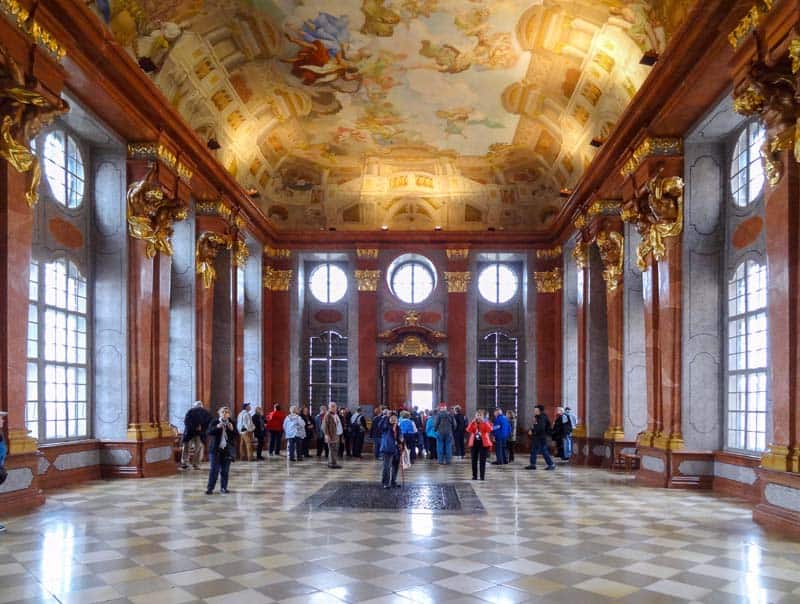
Estimated reading time: 10 minutes
By Jim Ferri
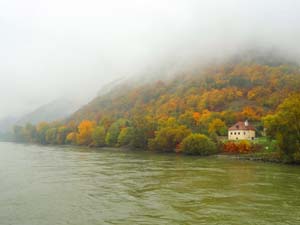
I first saw the Melk Abbey as I was cruising down the Danube. It was a magnificent sight.
As our river cruise ship moved slowly up the Danube through Austria’s beautiful Wachau Valley, I watched the morning fog rise slowly off the vineyards that ran down the hillsides to the river.
It was a beautiful, still morning with barely a sound to be heard, except for the occasional slap of water against the hull.
Our destination was the riverside town of Melk, just about 60 miles west of Vienna. We had sailed there to visit the famous Melk Abbey, one of the largest and most beautiful abbeys in Europe.
Leaning against the deck rail as we slipped through the river fog, I was lulled by the rhythm of the ship and the silence of the river and quiet countryside. And then, as we came around one bend, there it was, a vast yellow fortress-like building sitting majestically above the town.
It was beautiful and mesmerizing, and I couldn’t help but just stare at it as we slipped by to find our berth.
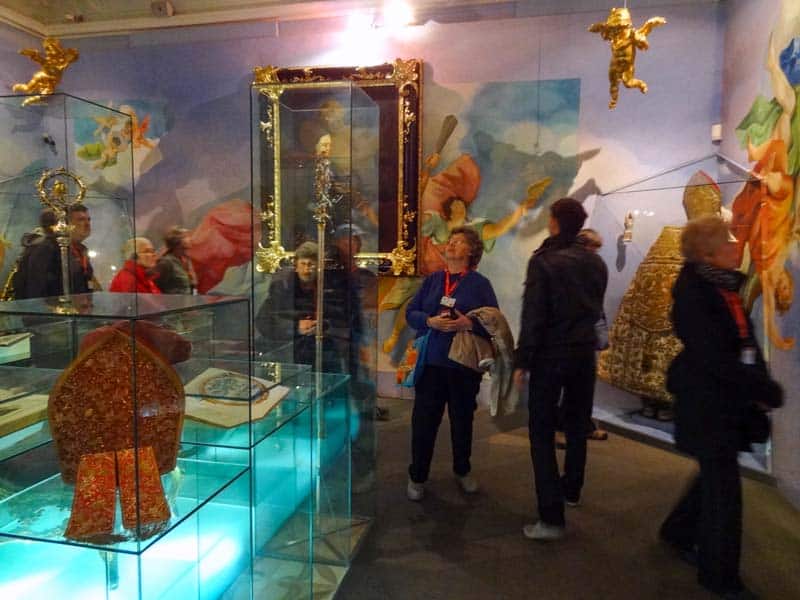
A Center of Learning
Melk Abbey is one of the architectural jewels of Austria. It was founded in 1089 when Leopold II of the House of Babenberg gave one of his castles to Benedictine monks. Set on a rocky outcrop above the small town, the monks began the task of further fortifying and expanding the castle.
In medieval times Melk Abbey was one of the most famous centers of learning and its library among the greatest in Christendom. Today it still houses more than 85,000 leather-bound books and 1,200 manuscripts, many hand-written, from the 9th–15th centuries.
It’s still functioning as a Benedictine abbey, with monks continuing to live in it. Although you’ll rarely see any monks on a visit, you will be amply rewarded by its incredible Baroque architecture and artworks. It’s well worth a drive or train ride from Vienna or Salzburg.
Melk Abbey, Austria – 497 Rooms and 1365 Windows
Centuries after being gifted by Leopold, Melk Abbey was destroyed by fire in 1297, although the monks were able to save most of the manuscripts. It also incurred more damage during the Turkish invasion in 1683, after which the monks rebuilt it in Baroque style in 1702. It is the building one sees today, a vast abbey with 497 rooms and 1365 windows.
A second fire, in 1974, marred parts of the interior and its artworks. It necessitated a large-scale 26-year restoration beginning in 1975.
Despite the fires, it’s incredible the Abbey also a survivor of the Reformation of the 16th century, and occupation by Napoleon in the 19th century and the Nazis in the 20th.
Today 30 monks still live in and maintain the Abbey, which also houses a school of 900+ students. While farming and agriculture sustained them in the past, today they survive and maintain the Abbey thanks to the admission paid by the ½ million tourists who visit it every year.
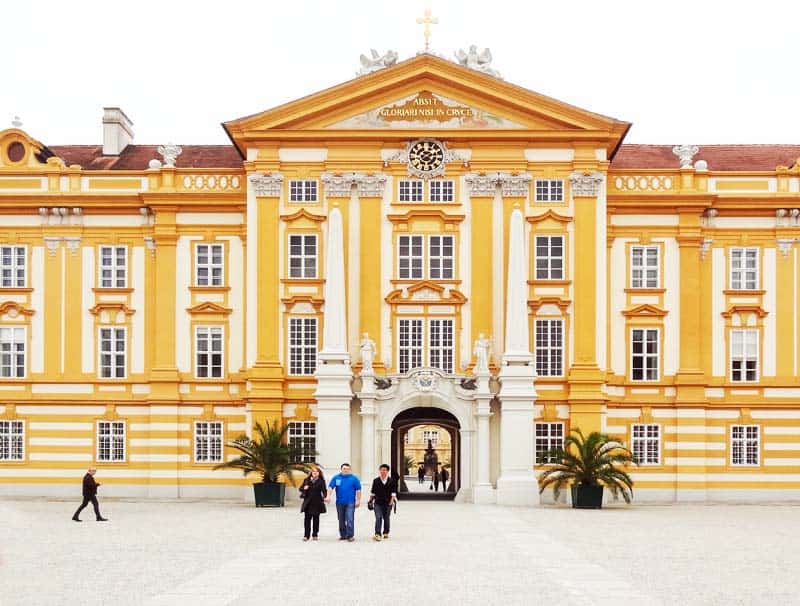
Melk Abbey, (Almost) Everything Baroque
When you enter the Abbey’s inner courtyard, you see everything is Baroque except the four frescoes at the top along the roof line. During the renovation of the building, it was impossible to save the frescoes, so the monks decided to paint more modern ones.
Continue across the courtyard, and you’ll be following in the footsteps of many notables who used to stay here, including Mozart and Maria Theresa, Archduchess of Austria.
Once inside, you’re brought to the second floor to the Imperial Rooms and their incredible artworks. Before we entered the galleries, however, we saw an exhibition highlighting the history of Melk Abbey, with the rooms bathed in green and blue lights.
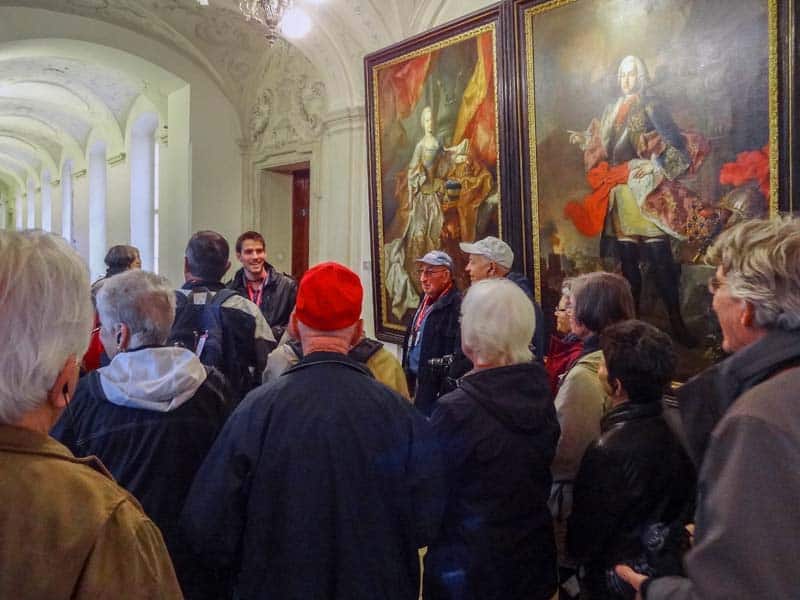
A Beautiful Hall, an Incredible Library
We wandered through the exhibition, following our guide into the ornate Marble Hall. The hall is the dining area where the monks hosted noble guests. Musicians sat and played in an outer room so as not to be seen.
Today Marble Hall is empty of furnishings which allows an uninterrupted view of the entire, magnificent room. All is not what it seems, however. The doorposts are marble, but everything else is trompe-l’oeil painting, imparting a feeling of incredible richness to the room.
Most incredible is the hall’s ceiling, an allegorical masterpiece by Baroque artist Paul Troger depicting Pallas Athena on a chariot drawn by lions. The flat ceiling is faux, painted in the 18th century to give it a three-dimensional look.
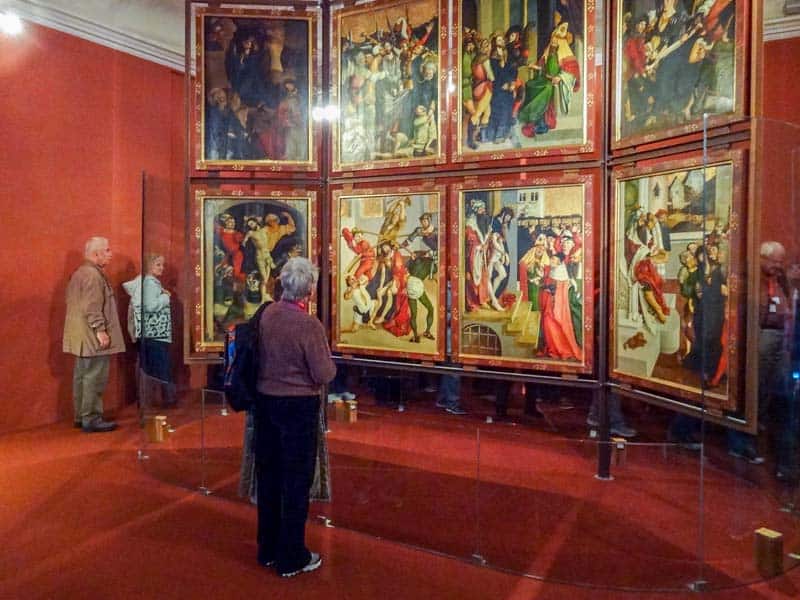
One of the most incredible areas of Melk Abbey is its library, where, unfortunately, they don’t allow you to take photos (see below for photos taken earlier). Its 12 rooms have inlaid wood, some of it gilded, and are filled with more than 100,000 volumes of old books and 1186 manuscripts. The oldest book is from 988.
The books in Melk Abbey are on many different topics, including history, law, medicine, etc., and are in several languages, including English, Hebrew, and Latin.
While most of the books are from the 15th, 16th, and 17th centuries, the bindings are from the 18th century. The monks rebound them because the monks wanted everything to be symmetrical.
While any type of fire was forbidden in the library, the monks did study at night by candlelight. They did so by accessing six hidden doors in the bookcases, constructed so they could sneak in and out of the Abbey. Even when pointed out by your guide, you need to look closely to see them.
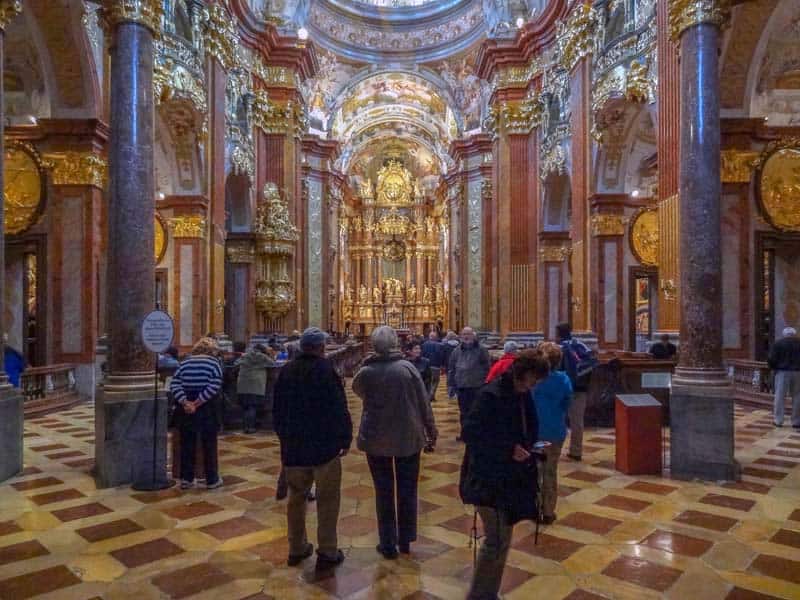
The Real Treasure of Melk Abbey
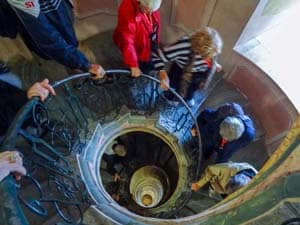
Our guide told us to take the spiral staircase down to the Abbey’s church as we exited the library.
Everyone was shocked when we stepped onto the staircase since it appeared hundreds of feet deep. Like the faux ceilings, though, it turned out only to be an illusion – the monks had put mirrors at the top and bottom of the staircase to trick visitors.
Once down the staircase, though, we quickly found that the grandest part of Melk Abbey is its beautiful Baroque church. It is an ecclesiastical treasure house with cavorting cherubs, gilded saints, and a gold pulpit.
Marble pillars support a ceiling of bright frescoes and a 200-foot-tall dome. Look closely in the apse, and you can see the gilded windows of private rooms in which royalty worshiped.
We finished our visit at a Keller adjacent to the Abbey where we were led through a wine tasting by our humorous host, before setting off to wander about the sleepy little town of Melk.
How To Get to Melk Abbey
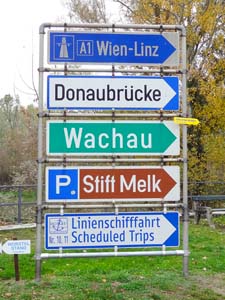
The most convenient and easiest way to get to Melk Abbey from Vienna is by car. The 60-mile trip takes only an hour on the A1 Autobahn, linking Vienna with Salzburg and Munich. There are prominent signs for the village of Melk on the main road, but once off it, follow the signs for Stift Melk or Stift to reach Melk Abbey.
Alternatively, you can easily reach Melk via train from Vienna’s Westbahnhof, also about an hour trip. Trains depart several times an hour with a one-way ticket costing approximately US$20.
From Salzburg, Melk is about a two-hour drive on the A1. Once off the main highway, follow the directions given for Vienna above.
The train from Salzburg to Melk is a 2 1/2-hour journey, with trains departing the Salzburg Hauptbahnhof every half-hour. Fares are approximately US$10-60 each way.
You may also enjoy: Things to Do in Innsbruck, Austria in 48 Hours / Hallstatt – the Prettiest Lakeside Village in Austria / Best Things to Do in Salzburg, Beyond Mozart and Maria / Imperial Vienna Blooms In the Spring
N.B.
Although you’re no longer allowed to take photos in the Abbey library, reader Paul Abramchik sent me the photos below that he had taken of the library during a visit to the Abbey in 2008. How fortuitous for all of us! His photos certainly give you a better idea of the beauty of the place more than my words ever could. Thank you Paul.
If You Go:
Stift Melk
Abt-Berthold-Dietmayr-Str. 1
A 3390 Melk, Austria
Tel. 0043(0)2752-555-0
https://www.stiftmelk.at/en/
@ [email protected]
Open: opening days and times are changing monthly due to the pandemic. See the updated times here.
Admission: Visit with guide: Adults €16 / Students (with ID, up to 27 years of age) €9,50 / Family ticket
(parents with their children up to 16 years of age) €32
Visit without guide: Adults €13 / Students (with ID, up to 27 years of age) €6,50 / Family ticket
(parents with their children up to 16 years of age) €26
Austrian Tourist Office
120 W 45th Street
New York, NY 10036
Tel: (212) 944-6880
www.austria.info/


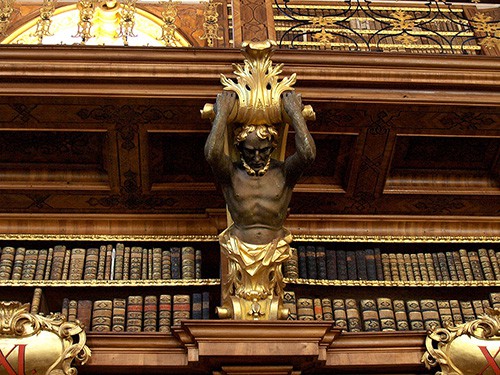
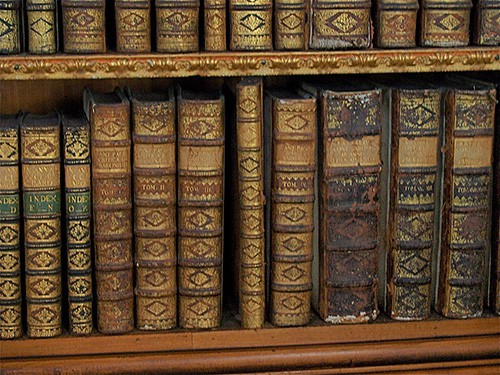
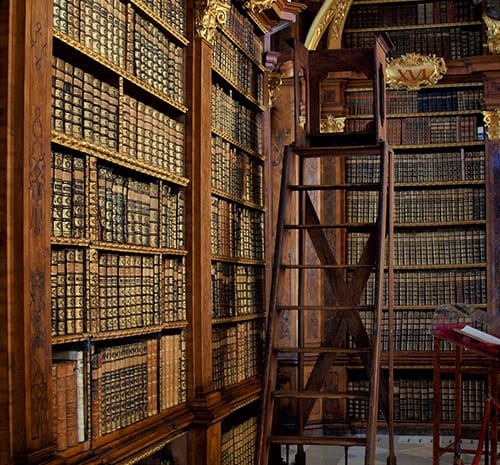
When my daughter-in-law and I visited the Abbey (Danube river cruise), we were both in-awe … She told everyone back in the U.S. about its imposing, magical architecture. Thanks for describing Melk Abbey to your readers …. and I’ve got to admit … you MUST see it from the Danube!
Yes, it is really interesting, isn’t it? It is a really interesting place to visit.
On a church sponsored trip to Germany in 2010 to see the Passion Play at Oberammegau, our tour took us to Austria and to Melk Abbey. It was a wonderful addition to our itinerary and we truly marvelled at what we saw. It was while there that we saw a river boat cruising down the Danube. In July we get to see the Abbey from the Danube along with four other couples on that original trip. Looking forward to taking pictures from the opposite perspective.
Angela –– you’re going to love cruising on the Danube. Get up early in the morning if that’s when you’ll be cruising through the Wachau Valley. It’s the most beautiful stretch of the Danube.
I agree with JIm … there is no more awe-inspiring way to approach the Abbey than from the river …. I’m biased, I know, but I love Europe’s great waterways in December, when the forests are blanketed with snow 🙂
All the optical illusions and hidden doors are very interesting. Thanks for a little history lesson.
Visited the melk Abbey this afternoon. Sweltering heat inside and out followed by heavy rain but nevertheless was a sight to see.
Re Gutenberg Bible – Yale was bestowed the Bible by the Harkness family who purchased it from Melk in 1926 via the Philadelphia bookseller A.S.W. Rosenbach at Anderson Galleries auction in New York City (hence it is called The Melk Copy).
Thank you for explaining the origin of The Melk Copy, Asta. That’s very interesting.
Jim – Melk Abbey was one of our favorite stops on our Danube trip. We were fortunate to be able to attend a Mass while we were there, so that made it extra special. Eager to get traveling again! Thanks for this memory!
Hi Pat,
I’m glad you were able to stop there. As you’ve seen for yourself it’s an interesting place. Always glad to stir up memories!
Jim